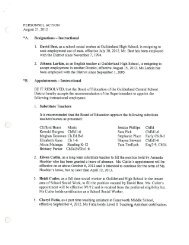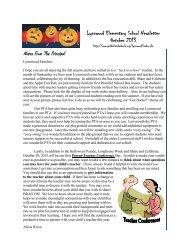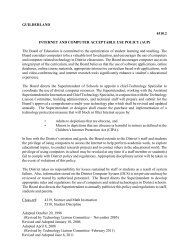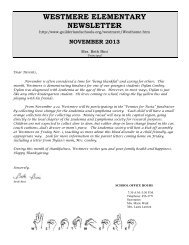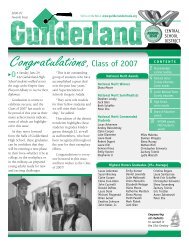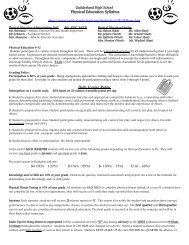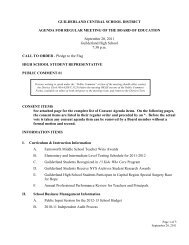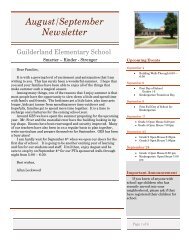How to Bring Our Schools Out of the 20th Century - Guilderland ...
How to Bring Our Schools Out of the 20th Century - Guilderland ...
How to Bring Our Schools Out of the 20th Century - Guilderland ...
Create successful ePaper yourself
Turn your PDF publications into a flip-book with our unique Google optimized e-Paper software.
• Enable students <strong>to</strong> recognize that which is common <strong>to</strong> all human experience and <strong>to</strong> accept that<br />
which is different.<br />
• Enhance students’ abilities <strong>to</strong> analyze, compare and contrast, syn<strong>the</strong>size, improvise, and<br />
examine culture through a language and perspective o<strong>the</strong>r than <strong>the</strong>ir own.<br />
• Begin language study as early as possible in an interdisciplinary environment in which all<br />
students are included.<br />
Rationale<br />
Starting instruction early does more than allow students <strong>to</strong> develop pr<strong>of</strong>iciency through<br />
<strong>the</strong>ir years <strong>of</strong> study. Recent research shows that it facilitates learning at a time when <strong>the</strong>ir brains<br />
are most readily adaptable <strong>to</strong> <strong>the</strong> task (Steir, Washing<strong>to</strong>n Post). “The research is clear that any<br />
language a child learns through age 10 is s<strong>to</strong>red in one part <strong>of</strong> <strong>the</strong> brain where it can be<br />
distinguished early. After that it gets s<strong>to</strong>red in a different part.” (Tollefson, ASCD Curriculum<br />
Update). This is why high school students have <strong>to</strong> switch back and forth translating from<br />
English <strong>to</strong> <strong>the</strong> foreign language being studied (Robinson, 1998). Dr. Susan Curtis, pr<strong>of</strong>essor <strong>of</strong><br />
linguistics at U.C.L.A. has found that, “<strong>the</strong> power <strong>to</strong> learn language is so great in <strong>the</strong> young<br />
child... <strong>the</strong>y can learn as many spoken languages as you can allow <strong>the</strong>m <strong>to</strong> hear systematically.<br />
Children just have this capacity. Their brain is just ripe <strong>to</strong> do this.” (Curtis, 2004) When<br />
language begins earlier, it allows for more practice, thus leading <strong>to</strong> greater fluency and<br />
understanding.<br />
The <strong>Guilderland</strong> program will be designed <strong>to</strong> meet <strong>the</strong> characteristics <strong>of</strong> effective<br />
elementary school foreign language programs:<br />
1. Access and Equity<br />
All students, regardless <strong>of</strong> learning styles, achievement levels, race/ethnic origin,<br />
socioeconomic status, home language, or future academic goals, have opportunities<br />
for language study.<br />
2. Program Goals and Program Intensity<br />
Program goals are consistent with <strong>the</strong> amount <strong>of</strong> time actually provided for<br />
instruction. The desired program outcomes determine time allocations for<br />
elementary school programs. FLES programs are designed <strong>to</strong> provide a sequential<br />
language learning experience aiming for some degree <strong>of</strong> language pr<strong>of</strong>iciency.<br />
3. Extended Sequence<br />
Elementary and middle/junior high school foreign language programs are <strong>the</strong><br />
foundation for a long, well-articulated sequence <strong>of</strong> carefully developed curricula<br />
that extend through grade 12. Students in such programs can develop increased<br />
language pr<strong>of</strong>iciency and cultural competence.<br />
4. Articulation<br />
Articulation <strong>of</strong> <strong>the</strong> extended sequence is both vertical and horizontal, including <strong>the</strong><br />
elementary school, <strong>the</strong> middle/junior high school, and <strong>the</strong> high school. This<br />
articulation is <strong>the</strong> result <strong>of</strong> consensus, careful planning, and moni<strong>to</strong>ring among<br />
language teachers, administra<strong>to</strong>rs, and parents at all levels. Students in <strong>the</strong>se<br />
5



